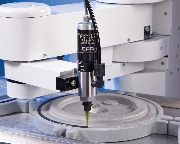 Tabletop dispensing robots are a cost-effective way to increase output, accuracy, and quality in manufacturing processes where assembly fluids like adhesives, lubricants, and silicones must be applied—without hiring additional personnel or making a major investment in capital equipment.
Tabletop dispensing robots are a cost-effective way to increase output, accuracy, and quality in manufacturing processes where assembly fluids like adhesives, lubricants, and silicones must be applied—without hiring additional personnel or making a major investment in capital equipment.
These compact, versatile machines have the capability to apply virtually any assembly fluid with much greater accuracy and consistency than manual applicators like squeeze bottles or brushes, and more precise placement than operator-controlled pneumatic dispensers. By increasing productivity, improving quality and reducing costs, they can provide a significant advantage in today’s competitive global market.
Though still used at some companies, manual fluid applicators like squeeze bottles and brushes provide minimal control over the amount of fluid applied, and rely entirely on the operator to control the size and placement of the fluid deposit.
Pneumatic fluid dispensers are a dramatic improvement over these manual application tools. By using controlled air pressure and precision timers to regulate the amount of material applied, they remove subjective operator judgment from the dispensing equation. This improves accuracy while reducing rework, rejects and waste.
With a precision fluid dispenser, the amount of fluid applied is determined by three parameters: the size (gauge) of the dispensing tip, the pressure applied to the fluid, and the length of time pressure is applied (“dispense time”). Dispense time, which can be adjusted in increments as small as .0001 seconds is the most precise way to determine how much material is applied.
 Because these devices produce consistent fluid deposits regardless of who is performing the operation, they are ideal for manual dispensing applications. However, it is still up to the individual operator to determine where and at what rate fluid is applied. While the amount of fluid applied will remain constant, there will still be slight operator-to-operator variations in the placement of the deposit, and different operators will work at different speeds.
Because these devices produce consistent fluid deposits regardless of who is performing the operation, they are ideal for manual dispensing applications. However, it is still up to the individual operator to determine where and at what rate fluid is applied. While the amount of fluid applied will remain constant, there will still be slight operator-to-operator variations in the placement of the deposit, and different operators will work at different speeds.
This is where tabletop dispensing robots can provide a distinct advantage. Instead of relying on the operator to determine where to place the fluid deposit, a robot can be programmed to automatically position the dispensing tip so that fluid is applied in the same place on every part, every time.
Dispensing robots combine a precision fluid dispensing system (typically syringe-or valve-based) with an electronically controlled positioning platform. By automating both the positioning and dispensing processes, this setup allows fluids to be applied much faster and with much greater positioning accuracy than even an experienced operator can provide.
Once the syringe or dispense valve has been mounted on the positioning platform, a teaching pendant or PC is used to program the placement of the dispensing tip to produce the desired dot, line, circle, arc or fill.
With dispensing and positioning parameters set, the fluid can be automatically applied in the correct amount and location without further operator intervention. The operator simply loads the part or parts onto a fixture, places the fixture on the robot’s work table, and initiates the dispensing cycle. As fluid is being applied automatically, the operator is freed up to load the next fixture or perform other, more value-added tasks.
With all variations in deposit placement, deposit size, and fluid application speed eliminated, workflow and product quality are improved, bottlenecks are reduced, and production rates become more predictable.
Tabletop dispensing robots are also ideal for prototyping and low- to medium volume production runs, since switching between jobs basically requires little more than reprogramming the positioning and dispensing parameters. Even a totally different fluid—for example, a thick RTV silicone instead of a thin cyanoacrylate—can be applied by switching to the appropriate dispense valve.
CONCLUSION
Tabletop dispensing robots are an efficient way to increase output and quality while reducing production costs, and they are simple to reconfigure for different products and applications as needed.
Dispensing robots offer manufacturers seeking to gain a competitive edge a cost-effective, easily implemented way to:
- Produce more parts
- Reduce process time
- Reduce labor costs for each part
- Increase output without adding personnel
- Reduce rejects and rework related to inaccurate fluid placement
- Minimize non-value-added activity
- Prevent bottlenecks and reduce work-in-process
- Quickly produce different products on demand
